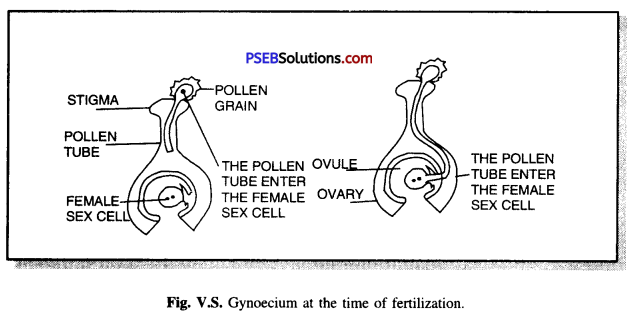Punjab State Board PSEB 7th Class Science Book Solutions Chapter 12 Reproduction in Plants Textbook Exercise Questions and Answers.
PSEB Solutions for Class 7 Science Chapter 12 Reproduction in Plants
Science Guide for Class 7 PSEB Reproduction in Plants Intext Questions and Answers
Think and Answer (Textbook Page No. 147)
Question 1.
What happens in the regeneration method of reproduction?
Answer:
In the regeneration method, the living organisms (plants and animals) repair themselves or grow their lost parts. In this way they replace their old or dead cells with new ones. Plants have a higher capacity of regeneration than animals.
Question 2.
Give two examples of organisms reproducing through binary fission.
Answer:
Asexual reproducing organisms by binary fission method are:
- Moss,
- Mould.
PSEB 7th Class Science Guide Reproduction in Plants Textbook Questions and Answers
1. Fill in the Blanks:
(i) Anther and filament form the ………………. of a flower.
Answer:
Stamens
![]()
(ii) In …………………….. reproduction seeds are formed.
Answer:
Sexual
(iii) Flowers having, both stamens and pistil are called …………………. .
Answer:
Bisexual
(iv) …………………… is an asexual mode of reproduction.
Answer:
Vegetative propagation
2. State True or False:
(i) Yeast reproduces by sexual and asexual means.
Answer:
False
(ii) Pollen grains are the male gametes of a flower.
Answer:
True
(iii) Ginger is a stem which bears nodes and internodes.
Answer:
True
(iv) Cutting and grafting are natural means of reproduction.
Answer:
False
3. Match the Column ‘A’ with Column ‘B’:
| Column ‘A’ | Column ‘B’ |
| (i) Sweet potato | (a) Micropropagation |
| (ii) Potato | (b) Bryophyllum |
| (iii) Leaf buds | (c) Artificial propagation |
| (iv) Grafting | (d) Yeast |
| (v) Tissue culture | (e) Spirogyra |
| (vi) Bud | (f) Adventitious root |
| (vii) Fragmentation | (g) Stem tuber |
Answer:
| Column ‘A’ | Column ‘B’ |
| (i) Sweet potato | (f) Adventitious root |
| (ii) Potato | (g) Stem tuber |
| (iii) Leaf buds | (b) Bryophyllum |
| (iv) Grafting | (c) Artificial propagation |
| (v) Tissue culture | (a) Micropropagation |
| (vi) Bud | (d) Yeast |
| (vii) Fragmentation | (e) Spirogyra |
![]()
4. Very Short Answer Type Questions:
Question (i)
In which mode of reproduction new plants are formed from only one parent ?
Answer:
By Asexual reproduction method new plants are formed from one parent. The different examples are:
- Grafting,
- Layering,
- Tissue culture.
Question (ii)
Which part of the flower develops into fruit ?
Answer:
After fertilization, the ovaries become fruit.
Question (iii)
How does yeast multiply ?
Answer:
The most common method of reproduction in yeast is asexual reproduction by budding in which a tiny bud forms on the outer surface of parent cell.
Question (iv)
Give one example where air helps in pollination.
Answer:
When the pollen cells ripe, they burst and the pollen grains come out of them. Pollen grains are very light. So when the wind blows, they are blown away by the wind. These pollinators reach the stigma of the flowers of the same plant or of another flower of the same species where the pollination takes place.
Question (v)
Name the reproductive parts of a flower.
Answer:
The reproductive parts of the flower are:
- Stamen (male reproductive part)
- Pistil (female reproductive part.)
Short Answer Type Questions:
Question (i)
Name different methods of asexual reproduction in plants.
Answer:
Asexual reproduction method is one in which no seed is required for growing new plants. A single plant produces a new plant. Asexual reproduction occurs in the following ways:
- Binary fission,
- Budding,
- Fragmentation,
- Spore formation,
- Regeneration.
Question (ii)
What is artificial propagation in plants ?
Answer:
Artificial Propagation. Artificial methods of reproduction are adopted to increase the number of useful plants. In these methods neither the reproductive organ takes part nor the seed is produced. In this artificial reproduction new plants grow through roots, stems, branches or leaves.
Below are some of the artificial methods:
- Grafting (stems and roots),
- Burying,
- Pruning,
- Tissue culture.
![]()
Question (iii)
What is tissue culture technique or micro propagation ?
Answer:
Tissue culture or micro-reproduction: This method involves taking some percent of the tissue from the tip of a plant branch because it contains rapidly developing, underdeveloped and undifferentiated cells. This mass has essential nutrients and hormones stored in it. Small parts of the tissue are kept in a medium until they begin to regenerate as plantlets. These buds (small plants) are transplanted in moist soil. This process is of reproduction is called tissue culture.
Question (iv)
Describe advantages of seed dispersal.
Answer:
Advantages of Seed dispersal:
- Seed dispersal spreads the plant over a large area.
- The probability of dense vegetation in one place decreases.
- Plants have the right growth.
- Plants get proper sunlight, water and minerals as competition for nutrients get reduced.
Question (v)
What is germination ? What are the conditions needed for germination ?
Answer:
After reaching the fertile soil, the seeds absorb water and swell up. Now the embryo
begins to germinate and its radical (root sprout) grows down into the soil and forms a root. The plumule grows upward in the air and develops leaves and shoot. It is a form of young small plant.
Essential conditions for germination:
All seeds need (i) water, (ii) oxygen (air) and (iii) proper temperature for germination. Some seeds also need the right amount of light. When the seed finds the right conditions, it activates and germinates the enzyme by moving water and oxygen inward from the outer layer and forms the seed root which receives water from the ground and forms a stem which moves towards the wind and leaves come out on the trunk from which the sun makes food in the light.
6. Long Answer Type Questions:
Question (i)
Describe different kinds of asexual reproduction with examples.
Answer:
Different kinds of post-asexual reproduction :
1. Fission.
This is the most common method of asexual reproduction in which an organism is divided into new organisms. It is common in plants and some single-celled organisms such as fungi, some mosses. In this method of reproduction the organism is divided into equal parts. The nucleus is divided into two parts and both parts evolve as individual adult.
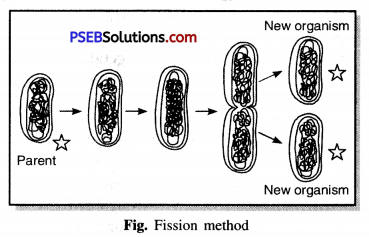
2. Budding.
The word bud means small outgrowth. In the process of budding, a small bud grows on the body of the parent organism and when it grows to full size individual, it detaches itself to form a new organism.
Budding is commonly seen in hydra and yeast.
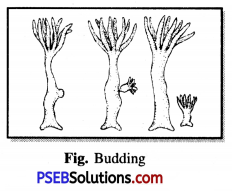
3. Fragmentation.
This type of reproduction occurs commonly in Algae. It appears as green spots in ponds, lakes or other standing water bodies. When abundant water and nutrients are available, they are multiplied by fragmentation. In this method an algae is divided into two or more pieces. Each piece develops into new organisms. This process is repeated many times.
Other examples are Star fish, some Worms, Lichens etc.
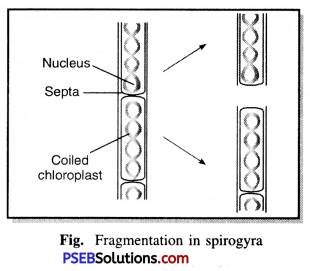
4. Spore formation.
Spores are very small, round-shaped structures for asexual reproduction. Spores have a hard outer layer and can stay in the air for a long time. Under favourable conditions, each spore germinates to develop into a new organism. Spore formation occurs in both unicellular and multicellular organisms. Rhizopus, a fungus that grows on bread, is produced by asexual reproduction by spores. Plants such as moss and fern also reproduced by spores.
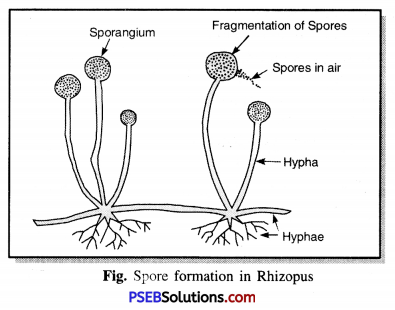
5. Regeneration.
The organism repairs and enhances its broken limbs in one form or another. New cells replace old or dead cells. The ability of living beings to repair themselves and grow their lost parts is called regeneration. Plants have a higher capacity of regeneration than animals.
![]()
Question (ii)
Explain different ways with examples in which plants can be reproduced vegetatively by artificial means.
Answer:
Artificial methods of vegetative reproduction.
Humans have adopted artificial methods of vegetative reproduction to increase the number of useful plants. Here are some of the methods:
1. Cutting, (i) (Cutting of stem). Cuttings are small nodules of stems or twigs, when they are pressed in moist soil then under favourable conditions roots germinates to grow as individual plant. As Bougainvillea, sugarcane, cactus and rose can grow by grafting of stem.
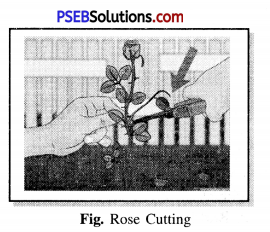
(ii) Root Cuttings. When the roots of plants like lemon, tamarind are buried in moist soil new shoots get developed.
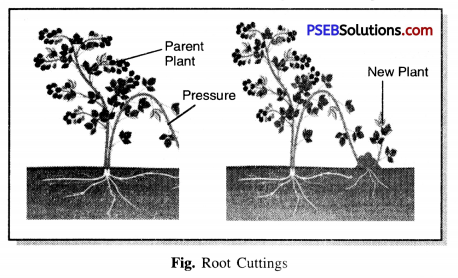
2. Layering.
A twig of a plant is twisted so that it touches the ground. The portion of plant in contact of ground is then covered with soil. This buried part develops roots under suitable conditions and upper end of this branch is already in the air. The plant thus developed is cut from the original plant and grown in a new place. Jasmine, Strawberry, Yoganvelia plants are grown by layering.
3. Grafting.
The desired plant is derived from two different individuals. Portion of one plant is called stock while stem portion from the other is called seion. Seion is from the plant that wants to propagate and is, therefore, grafted on the stock. Their ends are obliquely cut and the two are placed face to face. Then the two ends are tied tightly and wrapped with polythene.
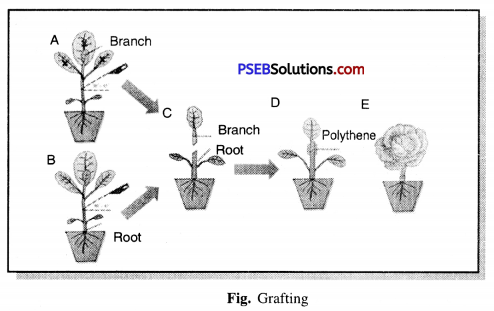
4. Tissue culture.
This method involves taking a tissue from the tip of a plant branch as it contains rapidly dividing, underdeveloped and undifferen-tiated cells. This tissue, is cultured and nurtured in a sterilized medium. The mass of tissue develops as an individual plant let. This technique is useful in growing a number of rare and endangered plants which cannot grow under natural conditions.
With this method many plants can be grown in a very short time. This technique is used in disease free orchids, carnations, gladiolus, chrysanthemums, potatoes.

Question (iii)
What is pollination ? What are the two types of pollination ? Discuss the different agents of pollination with examples.
Answer:
Pollination.
It is the act of transferring pollen grains from the male anther of a flower to the female stigma. The goal of every living organism, including plants, is to create offspring for the next generation. One of the ways that plants can produce offspring is by making seeds. Seeds contain the genetic information to produce a new plant

Types of pollination. There are two types of pollination action:
1. Self-pollination.
This type of pollination occur in asexual flowers, when the pollens of the same flower from the pollen cell (Anther) go to the pollen stem (Stigma) of saffron, this action is called self-pollination, because their genes are similar. This type of pollination is seen in Tomato, mustard etc.
2. Cross-pollination.
In this type of pollination the pollen grains move from the pollen cells (Anther) of one flower to the pollen stalk (Stigma) of another flower. This pollination takes place between the flowers of the same plant or between the flowers of two different plants of same species. In plants cross-pollination is done by air, insects, water and animals.
Various factors of pollination:
1. Air pollination. Many plants are pollinated by wind. With strong winds, pollens of one flower reach the stigma of the other plant. Examples – wheat, cotton, sunflower, millet,
2. Insect pollination. Insects (butterflies and bees) are attracted to flowers because of the color and fragrance of the flowers. Insects help in transferring pollen grains from one flower to another through their feet. Examples are figs, flies, bees etc.
3. Pollination by water. The pollen of the flowers of the plants growing in the water flows with the water and the pollens of the one flower reach the stigma of other flower. Examples are lotus flower, water lily etc.
4. Pollination by animals. Some plants are pollinated with the help of birds and animals like- bats, humming bird and squirrels.
Question (iv)
Explain the process of fertilization.
Answer:
Fertilization action after pollination.
After pollination pollen grains enter a small tube, called the pollen tube. The female pollen reaches the-ovaries through the stigma or vertebrae and then enters the ovule. There is a combination of male and female gametes. The combination of male gamete and female gamete (to form a zygote) is called fertilization.
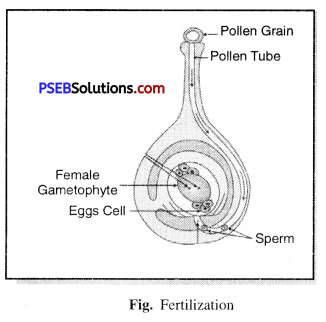
Question (v)
List the different steps in the formation of seeds and fruits.
Answer:
Fruit and seed formation. The following changes occur in the flower after fertilization:
(1) After fertilization the ovaries get transformed into fruits and ovules get transformed into seeds. The rest of the flowers wither and fall off.
(2) A seed is a developed egg that contains embryos and nutrients. This is covered with a secure layer. This is called seed peel.
(3) Fruits can be fleshy and juicy or dry and hard. Mangoes, apples, oranges are fleshy and juicy fruits while almonds and walnuts are dry and hard fruits.
![]()
Question (vi)
What is dispersal ? Explain with examples the different ways in which seeds get dispersed.
Answer:
Seed dispersal. The movement of seeds from one place to another by any means / factor like air, water, insects, birds, human beings and animals so that the seed survives is called seed dispersal.
Different methods of seed dispoersal:
(1) By wind
(2) By water
(3) By animals
(4) By humans
(5) By explosive process.
1. By wind. The seeds to be scattered by wind are small and light. Maple and Drumsticks seeds have wings. So they fly in the air and go far away. Seedlings with light grass seeds, acacia, cactus, cotton seeds and sunflower also fly with wind.
2. By water. Water lilies, lotuses and coconut fruits keep floating on the water so as their pollens. Water waves cany them far.
PSEB Solutions for Class 7 Science Reproduction in Plants Important Questions and Answers
1. Fill in the Blanks:
(i) Production of new individuals from the vegetative part of parent is called ……………. .
Answer:
vegetative propagation
(ii) A flower may have either male or female reproductive part. Such a flower is called ……………………
Answer:
unisexual
(iii) The transfer of pollen grains from the anther to the stigma of the same or of different flower of the same kind is known as ………………. .
Answer:
self- pollination
(iv) The fusion of male and female gametes is termed as ………………. .
Answer:
fertilization
(v) Seed dispersal takes place by means of ……………….. , ………………. , and ……………… .
Answer:
water, wind, animals
2. Match the Column ‘I’ with Column ‘II’:
| Column ‘I’ | Column ‘II’ |
| (a) Bud | (i) Maple |
| (b) Eyes | (ii) Spirogyra |
| (c) Fragmentation | (iii) Yeast |
| (d) Wings | (iv) Bread mould |
| (e) Spores | (v) Potato |
| (vi) Rose. |
Answer:
| Column ‘I’ | Column ‘II’ |
| (a) Bud | (iii) Yeast |
| (b) Eyes | (v) Potato |
| (c) Fragmentation | (ii) Spirogyra |
| (d) Wings | (i) Maple |
| (e) Spores | (iv) Bread mould |
![]()
3. Choose the Correct Answer:
Question (i)
The production of new individuals from their parents is called:
(a) Transportation
(b) Excretion
(c) Reproduction
(d) Respiration.
Answer:
(c) Reproduction.
Question (ii)
Out of the followings which is the vegetative part of a plant ?
(a) Stem
(b) Leaves
(c) Root
(d) All of the above.
Answer:
(d) All of the above.
Question(iii)
Out of the following which is reproductive organ of a plant ?
(a) Root
(b) Flower
(c) Leaf
(d) Stem.
Answer:
(b) Flower.
Question (iv)
Union of male and female garnets is called:
(a) Fertilization
(b) Pollination
(c) Zygote
(d) Reproduction.
Answer:
(a) Fertilization.
Question (v)
Which method is used for reproduction in a unicellular yeast ?
(a) Fragmentation
(b) Budding.
(c) Spore formation
(d) Binary fission.
Answer:
(b) Budding.
Question (vi)
Bryophyllum reproduces by its:
(a) Leaves
(b) Roots
(c) Stem
(d) Flowers
Answer:
(a) Leaves.
Question (vii)
Name the commonest method of vegetative reproduction in rose and sugarcane
(a) Fragmentation
(b) Budding
(c) Binary Fission
(d) Cutting.
Answer:
(d) Cutting.
![]()
Question (viii)
Name the factors, which are helpful in cross-pollination ?
(a) Air
(b) Water
(c) Insects
(d) All of the above.
Answer:
(d) All of the above.
4. State True or False
(i) Asexual reproduction is more common than sexual reproduction.
Answer:
False
(ii) Bacteria and yeast reproduce by asexual reproduction.
Answer:
True
(iii) The ability to regenerate in many organisms is through some method,
Answer:
False
(iv) A fertilized organ becomes a seed.
Answer:
True
Very Short Answer Type Questions
Question 1.
What is reproduction ?
Answer:
Reproduction. It is the ability of an organism to produce young ones of its own kind.
Question 2.
What is the role of reproduction ?
Answer:
- Propagation of species
- Evolution of species.
Question 3.
Name the two major kinds of reproduction.
Answer:
- Asexual reproduction and
- Sexual reproduction.
![]()
Question 4.
Name the various methods of vegetative propagation in plants.
Answer:
- Cutting
- Layering
- Grafting.
Question 5.
Name common method for vegetative propagation of Rose and Sugarcane.
Answer:
Cutting.
Question 6.
How do Spirogyra and Mucor reproduce asexually ?
Answer:
Spirogyra – Fragmentation and Regeneration,
Mucor – Spore formation.
Question 7.
Name the mode of vegetative propagation in (i) Begonia (ii) Mint.
Answer:
(i) Begonia – Leaf buds,
(ii) Mint – Runners.
Question 8.
How do yeast, sponges and hydra reproduce asexually ?
Answer:
All the three reproduce by budding.
Question 9.
Which part of bryophyllum can be used for vegetative propagation ?
Answer:
Leaf of Bryophyllum.
Question 10.
Give one example of each : Vegetative propagation by (i) root (ii) stem.
Answer:
(i) Vegetative propagation by root : Sweet potato.
(ii) Vegetative propagation by stem : Potato.
![]()
Question 11.
What is pollination ?
Answer:
Pollination. It is the transference of pollen grains from the anther of a flower to the stigma of a flower.
Question 12.
What term is used if the pollen is transferred to the stigma of same flower ?
Answer:
Self-pollination.
Question 13.
Where are pollens and ovules presents in flower ?
Answer:
- Pollens – Anther lobes
- Ovules – Ovary.
Question 14.
Which floral part is very attractive and coloured ?
Answer:
Petal.
Question 15.
What is fruit ?
Answer:
A ripened ovary.
Short Answer Type Questions
Question 1.
What is reproduction ? What are it basic types ?
Answer:
Reproduction.
All organisms show characteristic life cycle, involving birth, growth, maturation, reproduction and death. Rerproduction is one of the most important processes by which continuation of the species from one generation to another generation takes place. Older and aged organisms are replaced by new and younger organisms by reproduction.
There are two types of reproduction.
- Asexual reproduction
- Sexual reproduction.
Question 2.
Define asexual and sexual reproduction.
Answer:
Asexual Reproduction. It is a type of multiplication in which a young one is formed from a specialised or unspecialised part of a parent without the formation and fusion of sex cells, gametes.
Sexual Reproduction. It is a type of reproduction which takes place by the formation and fusion of gametes. It involves two major processes :
(a) Meiosis (reductional division) by which diploid sporophytic cells give rise to haploid gametes, and
(b) Fertilization, which reconstitutes the sporophytic diploid generation through gametic fusion.
Question 3.
Where do the moulds on bread come from ?
Answer:
The spores of the moulds are present in the air. The spores of the moulds under suitable conditions settle on the bread and grow.
Question 4.
Define the term unisexual and bisexual giving one example of each.
Answer:
Unisexual Organism. Male and female sex organs are present in different individuals such organisms are called unisexual. Example : Human.
Bisexual organism. Single individual having both male and female sex organs.
Examples : Most of the plants, Tapeworm, Earthworm.
![]()
Question 5.
Mention the reproductive parts of a flower.
Answer:
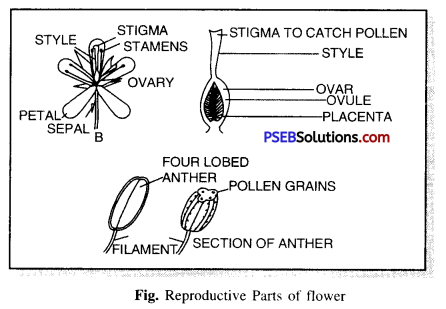
Reproductive parts of a flower:
Stamens. It consists of stalk and a flattened top called anther. Anthers produce pollen grains. The pollen grains produce two male gametes.
Carpels. It has a swollen ovary at the base and an elongated middle style and terminal stigma.
The ovary contains ovules. Each ovule has an egg or female gamete.
Question 6.
Differentiate between ovule and ovary.
Answer:
Ovule. A structure in the ovary of a plant that develops into a seed after fertilization.
Ovary. The enlarged basal portion of a pistil that bears the ovules in angiosperms.
Question 7.
Describe the different methods of asexual reproduction. Give examples.
Answer:
Type of asexual reproduction
(1) Budding
(2) Fragmentation
(3) Spore formation
(4) Vegetative propagation.
(1) Budding. It is a common method of reproduction in Sponges and Hydra. In this process, the new individual develops from a small outgrowth on the surface of parent called bud.
(2) Regeneration. It is a form of fission in which a parent individual divides into a number of parts, each of which regenerates the missing structures to form a complete organism. It occurs in flatworm, ribbon worm and annelids.
(3) Spore formation. An individual produces spores which during favourable conditions give rise to new individuals e.g. Mucor.
(4) Vegetative propagation. A part of plant body other than reproductive organ gives rise to new individual plant e.g. Rose stem cutting gives to new rose plant.
Question 8.
Explain the process of sexual reproduction in plants.
Answer:
Sexual Reproduction in plants. Plants have male and female reproductive organs respectively called stamens and pistil. Stamens produce male gametes. The eggs are produced by ovules of pistil. These two genitals can be in the same or different flowers. Male and female gametes fuse to form a zygote. Sexual reproduction in plants takes place by seeds.
Question 9.
State the main difference between Asexual and Sexual reproduction.
Answer:
Differences between Asexual and Sexual forms of Reproduction
| Asexual Reproduction | Sexual Reproduction |
| 1. The process involves only one cell or one parent. | 1. This process involves two cells or gametes belonging to either the same or different parents. |
| 2. The whole body of the parents may act as reproductive unit or it can be a single cell or a bud. | 2. The reproductive unit is called gamete which is unicellular and haploid. |
| 3. Only mitotic division takes place. | 3. Meiosis and fertilization are essential events. |
| 4. No formation of sex organ. | 4. Formation of sex organs are essential. |
Question 10.
Explain the differences between Self-pollination and Cross-pollination.
Answer:
Difference between Self-pollination and Cross-pollination.
| Self-pollination | Cross-pollination |
| 1. It occurs within a flower or between two flowers of the same plant. | 1. It occurs between two flowers borne on different plants of the same species. |
| 2. Flowers do not depend on the other factors for pollination. | 2. Agents such as insects, water and wind are required for ensuring pollination. |
Question 11.
How does the process of fertilization take place in flowers ?
Answer:
Process of fertilization in flowers:
- Pollination is transfer and deposition of pollen grains on stigma.
- Pollen grain germinates on the stigma. It gives rise to pollen tube which carries male gametes.
- A hypodermal cell of the nucleus in ovule enlarges and forms megaspore mother cell,
- The diploid mega-spore mother cell undergoes meiosis to form four mega-spores.
- The functional mega-spore enlarges into embryo sac.
- The process of nuclear fusion (syngamy) of the male nucleus and one egg nucleus is termed as fertilization. It forms diploid zygote. Second male gamete fuses with secondary nucleus to form primary endosperm nucleus.
- Angiosperms exhibit double fertilization.
- Fall of the petals, stamens, style and stigma.
- The ovules develop into seeds.
Long Answer Type Question
Question 1.
Write the various steps involved in the formation of a plant seed, starting from pollination.
Answer:
The transference of pollen grains from anther to stigma is called pollination. The stamens in flower have anthers which produce pollen grains. Gynaecium or pistil bears three parts ovary, style and stigma. After pollination pollen grains from pollen tubes. Inside the pollen tube the nucleus divides into vegetative nucleus and generative nucleus. This generative nucleus gives rise to two male gametes inside the pollen tube. Pollen tube after piercing through the style reaches the ovary. One of which fuses with the egg to form a zygote. The second male gamete fuses with two polar nuclei to form a triploid endosperm nucleus which finally gives rise to endosperm. So, the higher plant (angiosperms) shows the process of double fertilization.
Soon after fertilization the petals, stamens, stigma, and style fall off. The sepals wither and hold on to the ovule. The zygote divides in a fixed fashion to form an embryo. It may bear one or two cotyledons, an embryo axis made up of plumule and radicle. Radicle gives rise to root and plumule to shoot after germination of seed. Cotyledons contain food reserves.
